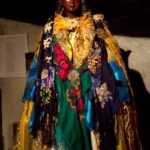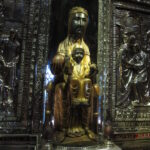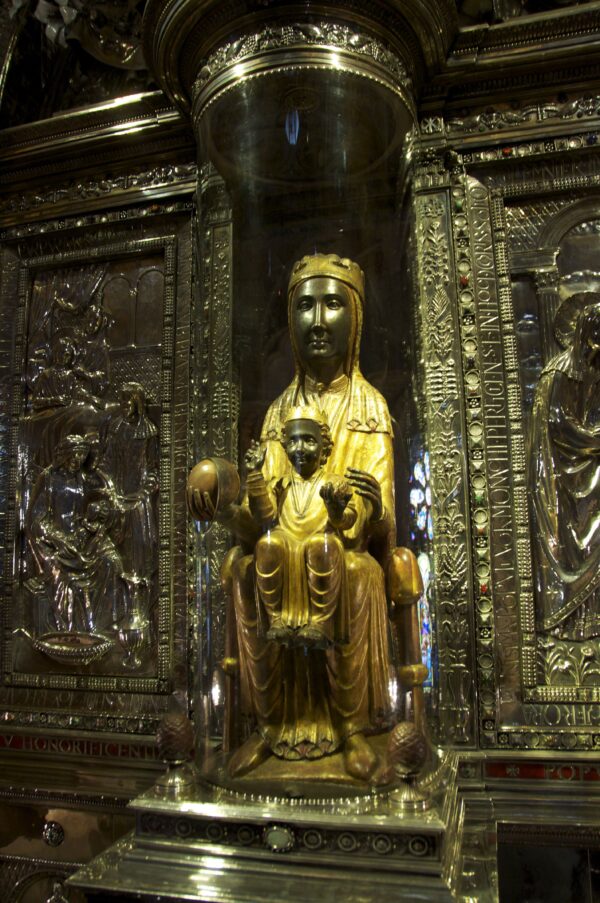
- The Historical Significance of the Black Madonna in Montserrat
- Unveiling the Mysteries of the Black Madonna's Origins
- The Artistic Representation of the Black Madonna: Symbolism and Meaning
- Pilgrimage to Montserrat: The Black Madonna's Role in Spiritual Journeys
- Legends and Myths Surrounding the Black Madonna in Montserrat
- Exploring the Cultural Impact of the Black Madonna on Catalan Identity
The Black Madonna of Montserrat, a revered icon within Catalonia, has captivated believers and historians alike for centuries. Its striking appearance and mysterious origins invite a deeper exploration into its age and significance, raising questions about the intertwining of faith and history.
In this article, we delve into The Enigma of the Black Madonna in Montserrat: Unraveling its Age, examining the various theories that surround this iconic figure. From its artistic features to its historical context, we aim to shed light on the enduring allure of the Black Madonna and the secrets that have yet to be uncovered.
The Historical Significance of the Black Madonna in Montserrat
The historical significance of the Black Madonna of Montserrat extends beyond its spiritual symbolism; it reflects the cultural and artistic heritage of Catalonia. As a central figure in the region's religious practices, it has played a pivotal role in shaping local identity and community cohesion. The Marian devotion associated with this icon has fostered a rich tradition of pilgrimage, attracting visitors from around the world who seek connection and solace.
Throughout the centuries, the Black Madonna has been a source of inspiration for numerous artists, contributing to the evolution of religious art in Europe. Notably, its unique representation has sparked debates about the nature of divine femininity and the role of women in spirituality. This figure embodies a blend of cultural influences, resulting in an iconic artistic style that resonates with diverse audiences.
- Symbol of Resistance: The Black Madonna has also emerged as a symbol of resilience during times of political turmoil, particularly during the Catalan struggle for identity and autonomy.
- Historical Artifacts: Associated relics and manuscripts related to the Black Madonna provide insights into the socio-political climate of medieval Catalonia.
- Community Identity: Festivals and traditions surrounding the Black Madonna reinforce local customs and strengthen communal bonds.
In summary, the Black Madonna of Montserrat is not merely a religious artifact but a living testament to the historical tapestry of Catalonia. Its significance is intertwined with the region's struggles, artistic developments, and communal narratives, ensuring its place as a pivotal icon in both religious and cultural contexts.
Unveiling the Mysteries of the Black Madonna's Origins
The origins of the Black Madonna of Montserrat are shrouded in mystery, leading to various theories regarding its creation and historical context. Some scholars propose that the statue dates back to the early medieval period, possibly crafted in the 12th century, while others suggest it may have roots in even older pagan traditions. This debate not only highlights the statue's age but also its significance as a cultural artifact that bridges different historical narratives.
One prevalent theory posits that the Black Madonna was sculpted by skilled artisans who infused the work with elements from both Christian and pre-Christian symbolism. This fusion is evident in its artistic features, such as the use of dark pigments that are thought to symbolize fertility and protection. Additionally, the deliberate choice of a blackened figure raises questions about the representation of divine femininity across various cultures.
- Artistic Influences: The Black Madonna's design reflects a synthesis of Gothic and Romanesque styles, illustrating the evolution of religious art during its time.
- Pilgrimage Traditions: The veneration of the Black Madonna has led to the establishment of pilgrimage routes that carry historical and spiritual significance.
- Historical Context: Studies of artifacts found in the region suggest that the Black Madonna may have served as a focal point during important sociopolitical events in Catalonia.
As researchers continue to explore the Black Madonna's origins, they uncover layers of meaning that resonate with both local and global audiences. The interplay of history, art, and spirituality surrounding this iconic figure underscores its enduring legacy and the quest for understanding its true age and significance. Each theory adds a new dimension to the narrative, making the Black Madonna a captivating subject for scholars and devotees alike.
The Artistic Representation of the Black Madonna: Symbolism and Meaning
The artistic representation of the Black Madonna in Montserrat serves as a profound symbol of the intersection between faith and cultural identity. The figure's dark hue has been interpreted in various ways, reflecting themes such as protection, healing, and maternal strength. This duality enriches the narrative surrounding the Black Madonna, making it a significant icon in both religious and artistic contexts.
In its visual presentation, the Black Madonna embodies a range of symbolic elements that resonate with viewers. The use of gold accents in the artwork often signifies divinity and transcendence, while the serene expression on the Virgin's face conveys compassion and maternal care. This intricate layering of meaning invites contemplation and reverence from those who encounter the statue.
- Maternal Archetype: The Black Madonna represents the divine feminine, embodying nurturing qualities that many cultures celebrate.
- Color Symbolism: The dark pigmentation is frequently associated with ancient traditions that regard black as a color of fertility and power.
- Artistic Techniques: The fusion of Byzantine and Gothic styles in the sculpture highlights the evolution of religious art across Europe.
Moreover, the Black Madonna's artistic representation has inspired countless artists, each interpreting her image through their cultural lens. This ongoing dialogue between art and spirituality not only reaffirms the statue's significance but also underscores its role as a timeless symbol of hope and resilience in the face of adversity.
Pilgrimage to Montserrat: The Black Madonna's Role in Spiritual Journeys
The pilgrimage to Montserrat, centered around the revered Black Madonna, is a journey that transcends mere travel; it embodies a profound spiritual quest for many. Each year, thousands of pilgrims visit this sacred site, seeking spiritual solace and connection with the divine. The act of pilgrimage itself becomes a transformative experience, filled with reflection and devotion, as individuals from diverse backgrounds converge in this spiritual haven.
Visitors are often drawn by the legend of the Black Madonna, believing in her miraculous powers and her role as a protector and guide. The pilgrimage fosters a deep sense of community among participants, who share their hopes, prayers, and stories. This collective experience reinforces the significance of faith and the enduring power of shared spiritual journeys.
- Rituals and Traditions: Pilgrims engage in various rituals, such as lighting candles and offering personal prayers, which deepen their connection to the Black Madonna and the community.
- Spiritual Reflection: The serene surroundings of Montserrat offer a perfect backdrop for meditation and introspection, allowing pilgrims to contemplate their life journeys.
- Historical Significance: The routes taken by pilgrims have historical roots, reflecting centuries of devotion and the cultural heritage of Catalonia.
As each pilgrim ascends the mountain to reach the sanctuary, they partake in a journey that is both physical and spiritual. The Black Madonna stands as a beacon of hope, reminding all who visit of the power of faith and the importance of spiritual exploration. For many, this pilgrimage is not just a visit to a religious site, but a crucial step in their personal quests for meaning and understanding.
Legends and Myths Surrounding the Black Madonna in Montserrat
Throughout history, the Black Madonna of Montserrat has been enveloped in a rich tapestry of legends and myths, each contributing to its mystique. One popular legend recounts how the statue was discovered in a cave by shepherds, who were guided by a celestial light. This narrative not only emphasizes the divine connection attributed to the Black Madonna but also reinforces her status as a miraculous figure in the eyes of local devotees.
Another captivating myth suggests that the Black Madonna possesses miraculous powers, able to heal ailments and offer protection to her followers. This belief has inspired countless testimonies from pilgrims who attribute personal transformations and answered prayers to their encounters with her. Such stories have fostered a deep sense of faith among the devotees, further solidifying the statue's role as a spiritual beacon.
The Black Madonna is also associated with various cultural celebrations and traditions, where her legends come alive through rituals and communal gatherings. These festivities often include processions, music, and prayer, illustrating how the myths surrounding her have woven into the fabric of Catalonian culture. The intertwining of these stories with local customs not only enhances the Black Madonna's significance but also enriches the collective identity of her followers.
In essence, the legends and myths surrounding the Black Madonna of Montserrat serve to deepen the emotional and spiritual connection that individuals feel towards her. These narratives encapsulate themes of divine intervention, community, and resilience, making the Black Madonna a symbol of hope and faith for many. As such, her story continues to evolve, reflecting both historical reverence and contemporary devotion.
Exploring the Cultural Impact of the Black Madonna on Catalan Identity
The Black Madonna's influence on Catalan identity is profound and multifaceted, transcending mere religious significance. As a cultural icon, she embodies the spirit of resilience and unity among the Catalan people, particularly during periods of political strife. Her presence has inspired a rich tapestry of artistic expression, folklore, and communal practices that reinforce regional pride and identity.
One of the most notable aspects of the Black Madonna's cultural impact is her role as a symbol of resistance. During the Catalan struggle for autonomy, she has been invoked as a figure of hope and strength, serving as a reminder of the community's shared history and aspirations. The following points illustrate her significance:
- Artistic Inspirations: Artists have depicted the Black Madonna in various forms, reflecting the evolving nature of Catalan art.
- Folklore and Myths: Local legends about her miraculous powers contribute to a rich oral tradition that reinforces cultural identity.
- Festivals and Gatherings: Events celebrating the Black Madonna serve to unite communities, fostering a sense of belonging and shared heritage.
Moreover, the Black Madonna fosters a deep sense of community through rituals and celebrations that honor her legacy. These gatherings not only highlight local customs but also create opportunities for individuals to connect with their cultural roots. The enduring devotion to her figure exemplifies how spirituality and identity are woven together in the fabric of Catalan society.
In essence, the Black Madonna of Montserrat stands as a potent symbol of Catalan identity, intertwining faith, culture, and history. Her impact resonates through generations, making her not just a religious figure, but a vital touchstone for the collective consciousness of the Catalan people. Through her, the rich cultural heritage of Catalonia continues to thrive and inspire.
 The Mystery of the Black Madonna: Unraveling the Connection to the Gypsy Community
The Mystery of the Black Madonna: Unraveling the Connection to the Gypsy Community When to Visit Montserrat: Morning or Afternoon? Exploring the Best Time for a Memorable Experience
When to Visit Montserrat: Morning or Afternoon? Exploring the Best Time for a Memorable Experience The Mysterious Black Madonna at Montserrat: Unveiling its Secrets
The Mysterious Black Madonna at Montserrat: Unveiling its SecretsIf you want to know other articles similar to The Enigma of the Black Madonna in Montserrat: Unraveling its Age you can visit the category WHERE YOU CAN GO.
Deja una respuesta










Read more!